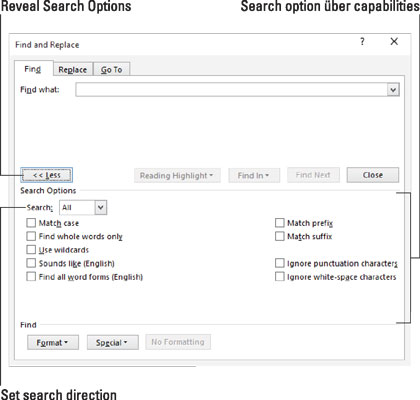The Find command in Word 2016 is brilliant enough to locate items in your document such as tab characters or text colored red. The puzzle is how to input that type of information in the Find and Replace dialog box. The secret is to use the Format and Special buttons lurking near the bottom of the dialog box.

Find special characters
To hunt down untypeable characters in your document, click the Special button in the Advanced Find dialog box. Up pops a list of 22 items that Word can search for but that you would have a dickens of a time typing.
Despite the exhaustive list, here are the few items you'll eventually (if ever) use:
Any Character, Any Digit, and Any Letter are special characters that represent, well, just about anything. These items can be used as wild cards for matching lots of stuff.
Caret Character allows you to search for a caret (^) symbol, which may not seem like a big deal, but it is: Word uses the ^ symbol in a special way for finding text.
Paragraph Mark is a special character that's the same as the Enter character — the one you press to end a paragraph.
Tab Character moves the insertion pointer to the next tab stop.
White Space is any number of blank characters: one or more spaces, tabs, empty lines, or a combination thereof.
Choose an item from the list to search for that special character. When you do, a special, funky shorthand representation for that character appears. The shorthand involves the ^ character and then another character, such as ^t to search for the tab character.
Find formatting
In its most powerful superhero mode, the Find command can scour your document for text and formatting. You can search for the formatting information itself or use it with text to locate specifically formatted text.
The secret to hunting down text formats is to use the Format button, found at the bottom of the Find and Replace dialog box. Click that button to view a menu full of formatting categories, such as Font, Paragraph, and Tabs. Choose a category to pluck out a specific format.
For example, suppose that you want to find the text red herring in your document. The text is italic and colored red. Follow these steps:
Click the Home tab.
In the Editing group, choose Find → Advanced Find.
The Find and Replace dialog box appears.
Type the text you're searching for.
In this example, that would be red herring.
Ensure that the dialog box details are displayed; click the More button if necessary.
Click the No Formatting button to remove any previously applied formatting.
The No Formatting button is available when you've previously searched for format attributes.
Click the Format button and choose Font from the pop-up list.
The Find Font dialog box appears
Choose Italic as the font style.
Select Red from the Font Color menu.
Yes, many shades of red dwell on the menu. Pick the correct one.
Click OK.
The Find Font dialog box goes away and you return to the Find and Replace dialog box. Below the Find What text box appears the search format. It lists which attributes the Advanced Find command is looking for.
Click the Find Next button to locate the formatted text.
If you want to search only for a format, leave the Find What text box blank (refer to Step 3). That way, you can search for formatting attributes without regard to what the text reads.
The Find command remembers your formatting options! The next time you want to search for plain text, click the No Formatting button (Step 5). Doing so removes the formatting attributes and allows you to search for text in any format.





